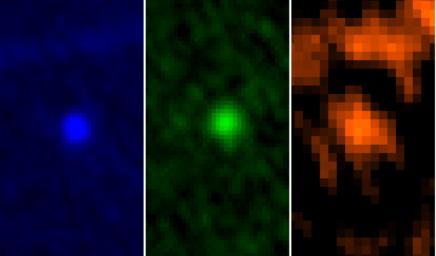
|
Herschel’s Three-Color View of Asteroid Apophis
- Click the image above for a larger view
- Full-Res JPEG (826 x 485) (25.7 kB)
- Full-Res TIFF (826 x 485) (1.2 MB)
Caption:
The Photoconductor Array Camera and Spectrometer instrument aboard the European Space Agency's Herschel Space Observatory captured asteroid Apophis in its field of view during the approach to Earth on Jan. 5 and 6, 2013. The image shows asteroid Apophis in three wavelengths: 70, 100 and 160 microns, respectively.
Background Info:
Herschel is a European Space Agency cornerstone mission, with science instruments provided by consortia of European institutes and with important participation by NASA. NASA's Herschel Project Office is based at JPL, which contributed mission-enabling technology for two of Herschel's three science instruments. The NASA Herschel Science Center, part of the Infrared Processing and Analysis Center at Caltech, supports the United States astronomical community. More information is online at: http://www.herschel.caltech.edu , http://www.nasa.gov/herschel , and http://www.esa.int/SPECIALS/Herschel/index.html .
Cataloging Keywords:
| Name | Value | Additional Values |
|---|---|---|
| Target | 99942 Apophis | |
| System | Near Earth Objects | |
| Target Type | Asteroid | |
| Mission | Herschel Space Observatory | |
| Instrument Host | Herschel Space Observatory | Hubble Space Telescope |
| Host Type | Space Telescope | |
| Instrument | Photodetector Array Camera & Spectrometer (PACS) | |
| Detector | ||
| Extra Keywords | Color, Infrared | |
| Acquisition Date | ||
| Release Date | 2013-01-09 | |
| Date in Caption | ||
| Image Credit | ESA/Herschel/PACS/MACH-11/MPE/ESAC | |
| Source | photojournal.jpl.nasa.gov/catalog/PIA16675 | |
| Identifier | PIA16675 | |
